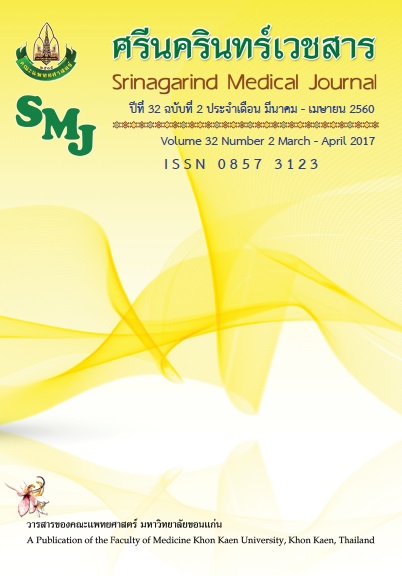Electrocardiogram Screening Tool for Risk Management among Adult Patients in Outpatient Department
Keywords:
EKG screening tool, risk management, เครื่องมือคัดกรองการตรวจคลื่นไฟฟ้าหัวใจ, การบริหารจัดการความเสี่ยงAbstract
Background and Objective: Screening for abnormality is the important role of nurses to prevent any morbidity and mortality while patients are waiting for physicians. Screening tool for abnormal electrocardiogram (EKG) will categorize patients according to EKG pattern in order to manage risk depending on urgency of the result, so that every patient will be screened by standard academic principles.
Methods: This research is the study of patients who received EKG examination. These patients are classified into 4 groups (Normal EKG, Abnormal EKG which doesn’t require emergency management, Abnormal life-threatening EKG, Life threatening events/Normal EKG). Patients will be managed according to EKG screening tool.
Results: Sample size included 400 people with mean age of 57.66 years old (SD 15.39) Out of 400 patients, 40.50 per cent are male. Most of the patients (68%) are categorized into “Abnormal EKG which doesn’t require emergency management” 19.75 per cent are from Medicine OPD. 19.50% are from General Practice OPD. Only one patient experienced abnormal life-threatening EKG, which is Atrial Fibrillation (AF) with rate of 184 bpm and was sent from Otolaryngology OPD.
Conclusion: EKG screening tool is designed for nurses to provide management according to urgency of each EKG category to make sure patients are taken care of effectively. The screening tool will help patients in terms of safety and standardize care for the patients.
การใช้เครื่องมือคัดกรองการตรวจคลื่นไฟฟ้าหัวใจ ต่อการบริหารจัดการความเสี่ยงในผู้ป่วยนอกผู้ใหญ่
เอื้อนจิต พานทองวิริยะกุล1*, ภัทรพงษ์ มกรเวส2, ชูวงศ์ พงษ์ไชยกุล1, ประภาพรรณ ทารักษา1, เต็มศิริ ศรีโพธิ์1
1งานบริการพยาบาล โรงพยาบาลศรีนครินทร์, 2ภาควิชาอายุรศาสตร์ คณะแพทยศาสตร์ มหาวิทยาลัยขอนแก่น
หลักการและวัตถุประสงค์: การคัดกรองเป็นบทบาทหน้าที่ของพยาบาลในการค้นหาปัญหาของผู้ป่วยเพื่อป้องกันไม่ให้อาการทรุดลงหรือเสียชีวิตระหว่างรอตรวจ เครื่องมือคัดกรองการตรวจคลื่นไฟฟ้าหัวใจใช้จำแนกประเภทผู้มารับบริการตามลักษณะคลื่นไฟฟ้าหัวใจในการบริหารจัดการความเสี่ยงสำหรับพยาบาลตามสภาวะเร่งด่วนที่แตกต่างกัน เพื่อให้ผู้รับบริการได้รับการคัดกรองทุกรายเป็นแนวทางเดียวกันตามหลักการวิชาการ
วิธีการศึกษา: ศึกษาในผู้มารับบริการการตรวจคลื่นไฟฟ้าหัวใจ จำแนกลักษณะคลื่นไฟฟ้าหัวใจเป็น 4 กลุ่ม (กลุ่มคลื่นไฟฟ้าหัวใจปกติ กลุ่มผิดปกติแต่ไม่ใช่ภาวะเร่งด่วน กลุ่มผิดปกติและอาจคุกคามต่อชีวิต และกลุ่มอาการที่มีผลคุกคามต่อชีวิตถึงแม้คลื่นไฟฟ้าหัวใจปกติ) ผู้รับบริการจะได้รับการบริหารจัดการความเสี่ยงตามแนวทางที่กำหนดไว้ในเครื่องมือคัดกรองการตรวจคลื่นไฟฟ้าหัวใจ
ผลการศึกษา: กลุ่มตัวอย่าง 400 ราย มีอายุเฉลี่ย 57.66 ปี (SD 15.39) เป็นเพศชาย ร้อยละ 40.50 ส่วนใหญ่มีผลการตรวจอยู่ในกลุ่มที่มีคลื่นไฟฟ้าหัวใจผิดปกติ แต่ไม่ใช่ภาวะเร่งด่วน ร้อยละ 68.00 ส่งตรวจจากห้องตรวจอายุรกรรม ร้อยละ19.75 รองลงมาจากห้องตรวจเวชปฏิบัติทั่วไป ร้อยละ 19.50 สำหรับกลุ่มตัวอย่างที่มีลักษณะคลื่นไฟฟ้าหัวใจผิดปกติ และอาจคุกคามต่อชีวิตพบ 1 ราย ชนิด Atrial Fibrillation (AF) อัตรา 184 ครั้ง/นาที โดยเป็นผู้ป่วยที่ส่งตรวจจากห้องตรวจหูคอจมูก
สรุป: เครื่องมือคัดกรองการตรวจคลื่นไฟฟ้าหัวใจช่วยให้พยาบาลจำแนกประเภทผู้รับบริการตามลักษณะคลื่นไฟฟ้าหัวใจในสภาวะเร่งด่วนที่แตกต่างกันได้อย่างรวดเร็วและเป็นแนวทางเดียวกัน ทำให้มั่นใจได้ว่าผู้รับบริการมีความปลอดภัยสูงสุด




